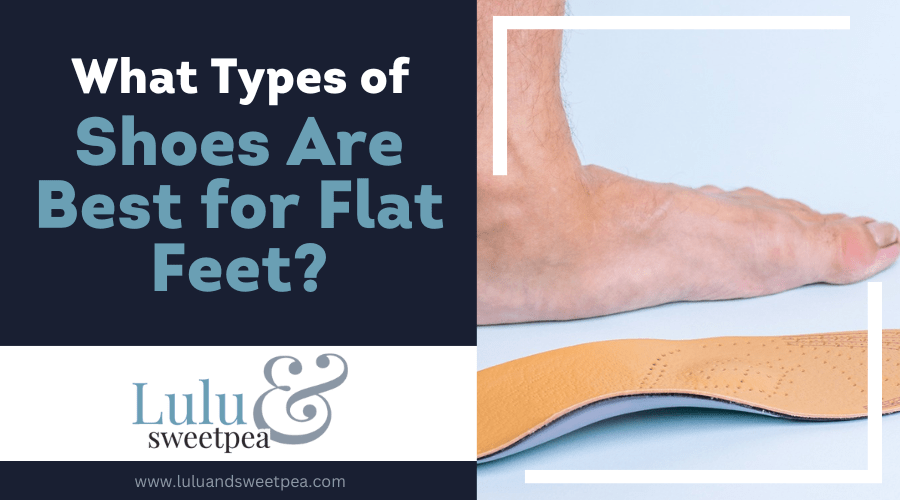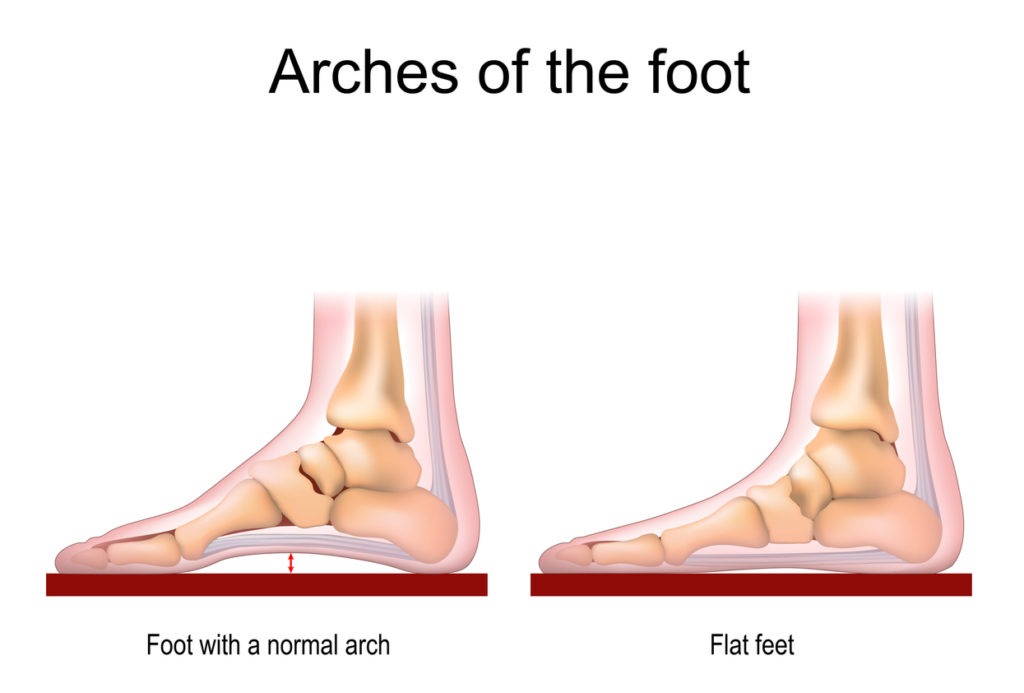The feet typically have an arched shape, as the sole of the foot curves up behind the toes, then curves back down to the bottom of the heel. If you have flat feet, it means you lack that arch – instead, your entire sole touches the ground when you stand. Most people with flat feet don’t experience any discomfort, but those who feel it affects how they stand and move might want to look for footwear that best supports their condition.
Learn more about flat feet and the types of footwear that they can use best:
What are Flat Feet?
People with flat feet have no arch or a very low arch on the soles, meaning that one or both feet may be flat on the ground. On a flat foot, the pressures are not distributed as they should be, so the foot tends to sink inwards. It can affect the body’s alignment when a person is standing, walking, or running. Some people don’t encounter many problems due to flat feet, but for some, it can cause pain in the foot and also in different parts of the body, such as the ankles, joints, knees, and hips.
A typical foot has 33 joints that hold 26 different bones together. It also has over 100 tendons, muscles, and ligaments. The arches provide the spring to the step and help distribute body weight across the legs and feet. Also, the structure of the arches determines how a person walks. The arches on the feet need to be flexible yet sturdy to adapt to the pressure and variety of walking surfaces.
For people with flat feet, their feet may roll to the inner side when they are standing, walking, or moving. This is called overpronation, which may also cause the feet to point outward.
There are two types of flat foot conditions:
- Flexible flat foot
This is a condition that is more common in children. When the child stands, the arch of their foot will disappear. When walking on tiptoes or when seated, the arch will be visible again.
- Rigid flat foot
When a person has this condition, their feet don’t arch, regardless of whether they are placing weight on their foot, like when standing. This condition can affect children and can develop during adulthood.
Causes of Flat Feet
It happened for most people with flat feet because the arch did not develop in early childhood. However, some people develop flat feet in adulthood due to different causes, such as:
- General wear and tear on bones and joints
- Injury to the foot or ankle
- Genetic factors (flat feet can be inherited)
- Diabetes
- Obesity (the excess weight causes stress on the arches of the feet)
- Rheumatoid arthritis
- Damage, rupture, or dysfunction of the posterior tibial tendon
- Tendonitis (tear due to overuse or other damage to the tendon)
- Nervous system or muscle diseases, such as muscular dystrophy, spina bifida, cerebral palsy, etc.
- Tarsal coalition (the bones of the foot fuse together unusually)
- Developmental anomalies that may occur during childhood, aging, or after pregnancy
Do Flat Feet Need Treatment?
Many people live with flat feet usually and experience few to no problems. But for others, it can cause unusual pain and pressure on the heels and balls of the feet. It can also put additional stress on the ankles, hips, and knees.
NOTE: Be sure to consult with your Doctor for ongoing foot related health issues
Oftentimes, people develop flat feet in childhood, but this condition can also develop well into adulthood. Many people with flat feet do not experience symptoms, but others will experience some, depending on the severity of the condition. Anyone with these symptoms must seek medical advice:
- Flat feet that have only developed recently
- Pain in the feet, ankles, and lower limbs
- Symptoms that do not improve with well-fitted, supportive shoes
- One of both feet becoming flatter
- The feet feel stiff, rigid, heavy, and unwieldy
Most qualified doctors and healthcare professionals can diagnose fallen arches by examining the feet and observing how the person stands and walks. The doctor will also inspect the feet and check their shape and functionality. The person’s medical history will also be considered so that the doctor may order an X-ray, MRI scan, CT scan, or electromyography for some cases.
Characteristics of Shoes Good for Flat Feet
When you have flat feet, you’ll find that you’re prone to foot and heel pain and discomfort after a long day of walking. To avoid this kind of pain, choosing shoes with adequate support and stability is essential. Here’s what you need to look out for when selecting shoes for flat feet:
Comes with arch support
In the case of flat feet, the midfoot really needs a lot of support. Look for shoes with a raised arch support in the middle of the sole to take the pressure off the middle of the foot. This can also help align the foot correctly so you don’t twist your knees, ankles, and hips as you move.
Provides enough sole support
Wearing shoes with a supportive sole is best for flat feet. Look for one with a firm but cushioned insole to provide support to the soles. The soles of the shoes or sandals must be flexible but not floppy. It must move along with the foot while you walk or stand.
Has heel support
In the heel area, it’s crucial to have a well-fitting counter to provide extra support, as people with flat feet tend to experience an inward collapse of the foot. This collapse can extend to the back of the foot, which may cause pain in the ankles. You will want shoes that enclose the heel so that the soles of the shoes and the foot move together. The shoes must be high enough in the back to keep the heel in contact with the sole of the shoes at all times.
If you’re looking for sandals and flip-flops, make sure it comes with some form of strap at the back to wrap around the heel and ankles.
Shock-absorbent
Shoes for flat feet must be shock absorbing, so choosing an outsole that will reduce the impact of the ground on your heels is essential. Shoes with a slightly raised heel are great, taking the pressure off the midsoles and relieving foot pain. A heel of 1-2 inches will be sufficient enough to alleviate foot pain caused by flat feet. Look for a thicker heel sole in sports shoes and raised heels in dress shoes.
Comes with lace or Velcro straps
Lace-up shoes or those with Velcro straps allow you to customize the way the upper part of the shoe fits around the foot. You can adjust the lacing or straps to accommodate the width of your upper foot so you can get even support and even distribution of your weight on the sole. By ensuring that the upper foot is fit snugly in the shoes, you can keep the sole firmly in place, allowing your feet to stay in contact with the bottom of the shoe. This can help correct gait issues you might develop when you’re trying to hold a loose shoe in place.
Can be fitted with orthopedic insoles
To get the best support, you may want to consult a pedorthist or a foot specialist to create custom-made foot orthotics that are ideally suited for your flat feet. With orthopedic insoles, you can choose any shoe with a removable insole and insert your custom-made insole. The removable insole can be removed and replaced, giving you enough support and comfort that your feet need.
Different Types of Shoes for Flat Feet
People with flat feet do not necessarily need specialized, custom-made shoes. You can choose from a lot of footwear typically sold in the market, but you only have to look for some characteristics to make sure it will be comfortable to wear, considering your condition. Here are some guidelines when shopping for certain types of shoes for flat feet:
Dress shoes
Dress shoes are excellent for flat feet because they usually come with a firm heel. This will make a day on your feet much more bearable. Shoes with leather uppers can also help keep that support for longer. If you need extra support, you can use orthotics. As much as possible, avoid dress shoes with pointed toes, as it may cause discomfort.
Sports or athletic shoes
If you have flat feet and are physically active, you’re more at risk of twisting your ankles and getting injured because you may tend to turn your ankles inwards. Besides injury, it also puts extra pressure on the feet, ankles, and knees. The good thing about quality sports shoes is that they are made for comfort and support to lessen the risk of injury. Choose those that are made of lightweight and breathable materials.
Orthopedic shoes
Orthopedic shoes are excellent for people with flat feet, but you must choose a pair carefully. Some are too soft for flat feet, and some do not have back support. Make sure to select orthopedic shoes with a rigid sole and ample support.
Sandals
People with flat feet may get less support from sandals, but if you choose well, you can avoid painful symptoms. Choose sandals that support the back of the foot and come with removable soles. However, keep in mind that sandals, by nature, are unlike closed shoes that can give your foot enough support while walking.


